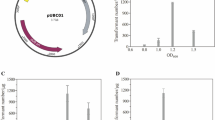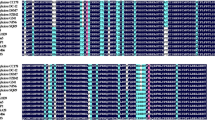Abstract
Both Gram-positive and Gram-negative bacteria can take up exogenous DNA when they are in a competent state either naturally or artificially. However, the thick peptidoglycan layer in Gram-positive bacteria’s cell wall is considered as a possible barrier to DNA uptake. In the present work, two transformation techniques have been evaluated in assessing the protocol’s ability to introduce foreign DNA, pBBRGFP-45 plasmid which harbors kanamycin resistance and green fluorescent protein (GFP) genes into a Gram-positive bacterium, Bacillus cereus EB2. B. cereus EB2 is an endophytic bacterium, isolated from oil palm roots. A Gram-negative bacterium, Pseudomonas aeruginosa EB35 was used as a control sample for both transformation protocols. The cells were made competent using respective chemical treatment to Gram-positive and Gram-negative bacteria, and kanamycin concentration in the selective medium was also optimized. Preliminary findings using qualitative analysis of colony polymerase chain reaction (PCR)-GFP indicated that the putative positive transformants for B. cereus EB2 were acquired using the second transformation protocol. The positive transformants were then verified using molecular techniques such as observation of putative colonies on specific media under UV light, plasmid extraction, and validation analyses, followed by fluorescence microscopy. Conversely, both transformation protocols were relatively effective for introduction of plasmid DNA into P. aeruginosa EB35. Therefore, this finding demonstrated the potential of chemically prepared competent cells and the crucial step of heat-shock in foreign DNA transformation process of Gram-positive bacterium namely B. cereus was required for successful transformation.





Similar content being viewed by others
References
Johnsborg O, Eldholm V, Havarstein LS (2007) Natural genetic transformation: prevalence, mechanisms and function. Res Microbiol 158:767–778. https://doi.org/10.1016/j.resmic.2007.09.004
Anagnostopoulos C, Spizizen J (1961) Requirements for transformation in Bacillus subtilis. J Bacteriol 81:741–746 https://jb.asm.org/content/jb/81/5/741.full.pdf. Accessed 12 Apr 2017.
Hanahan D (1983) Studies on transformation of Escherichia coli with plasmids. J Mol Biol 166:557–580. https://doi.org/10.1016/S0022-2836(83)80284-8
Laurenceau R, Péhau-Arnaudet G, Baconnais S, Gault J, Malosse C, Dujeancourt A, Campo N, Chamot-Rooke J, Le Cam E, Claverys J-P, Fronzes R (2013) A type IV pilus mediates DNA binding during natural transformation in Streptococcus pneumoniae. PLoS Pathog 9(6):e1003473. https://doi.org/10.1371/journal.ppat.1003473
Das S, Dash HR (2015) Chapter 2: cloning and transformation. Microbial Biotechnology - a Laboratory Manual for Bacterial Systems. Springer, India. pp. 35–44. https://doi.org/10.1007/978-81-322-2095-4_2
Belliveau BH, Trevors JT (1989) Transformation of Bacillus cereus vegetative cells by electroporation. Appl Environ Microbiol 55(6):1649–1652 https://www.ncbi.nlm.nih.gov/pmc/articles/PMC202922/pdf/aem00099-0337.pdf, accessed on 28 March 2016
Chuanchuen R, Narasaki CT, Schweizer HP (2002) Benchtop and microcentrifuge preparation of Pseudomonas aeruginosa competent cells. BioTechniques 33:760–763. https://doi.org/10.2144/02334bm08
Choi K-H, Kumar A, Schweizer HP (2006) A 10-min method for preparation of highly electrocompetent Pseudomonas aeruginosa cells: application for DNA fragment transfer between chromosomes and plasmid transformation. J Microbiol Methods 64:391–397. https://doi.org/10.1016/j.mimet.2005.06.001
Pyne ME, Moo-Young M, Chung DA, Chou CP (2013) Development of an electrotransformation protocol for genetic manipulation of Clostridium pasteurianum. Biotechnol Biofuels 6:50. https://doi.org/10.1186/1754-6834-6-50
Rattanachaikunsopon P, Phumkhachorn P (2009) Glass bead transformation method for gram-positive bacteria. Braz J Microbiol 40:923–926 https://www.ncbi.nlm.nih.gov/pmc/articles/PMC3768579/pdf/bjm-40-923.pdf
Zhao L, Xu R, Sun R, Deng Z, Yang W, Wei G (2011) Identification and characterization of the endophytic plant growth promoter Bacillus cereus strain MQ23 isolated from Sophora alopecuroides root nodules. Braz J Microbiol 42(2):567–575 https://www.ncbi.nlm.nih.gov/pmc/articles/PMC3769835/pdf/bjm-42-567.pdf
Li H, Guan Y, Dong Y, Zhao L, Rong S, Chen W, Lv M, Xu H, Gao X, Chen R, Li L, Xu Z (2018) Isolation and evaluation of endophytic Bacillus tequilensis GYLH001 with potential application for biological control of Magnaporthe oryzae. PLoS One 13(10):e0203505. https://doi.org/10.1371/journal.pone.0203505
Khaksar G, Treesubsuntornb C, Thiravetyana P (2016) Endophytic Bacillus cereus ERBP—Clitoria ternatea interactions: potentials for the enhancement of gaseous formaldehyde removal. Environ Exp Bot 126:10–20. https://doi.org/10.1016/j.envexpbot.2016.02.009
Deng Y, Chen H, Li C, Xu J, Qi Q, Xu Y, Zhu Y, Zheng J, Peng D, Ruan L, Sun M (2019) Endophyte Bacillus subtilis evade plant defense by producing lantibiotic subtilomycin to mask self-produced flagellin. Commun Biol 2:368. https://doi.org/10.1038/s42003-019-0614-0
Egamberdieva D, Wirth SJ, Shurigin VV, Hashem A, Abd_Allah EF (2017) Endophytic bacteria improve plant growth, symbiotic performance of chickpea (Cicer arietinum L.) and induce suppression of root rot caused by Fusarium solani under salt stress. Front Microbiol 8:1887. https://doi.org/10.3389/fmicb.2017.01887
Lin L, Song H, Ji Y, He Z, Pu Y, Zhou J, Xu J (2010) Ultrasound-mediated DNA transformation in thermophilic gram-positive anaerobes. PLoS One 5(9):e12582. https://doi.org/10.1371/journal.pone.0012582
Sun K, Liu J, Gao Y, Jin L, Gu Y, Wang W (2014) Isolation, plant colonization potential, and phenanthrene degradation performance of the endophytic bacterium Pseudomonas sp. Ph6-gfp. Sci Rep 4:5462. https://doi.org/10.1038/srep05462
Kovach ME, Elzer PH, Hill DS, Robertson GT, Farris MA, Roop RM II, Peterson KM (1995) Four new derivatives of the broad-host-range cloning vector pBBR1MCS, carrying different antibiotic-resistance cassettes. Gene 166:175–176. https://doi.org/10.1016/0378-1119(95)00584-1
Obranić S, Babić F, Maravić-Vlahoviček G (2013) Improvement of pBBR1MCS plasmids, a very useful series of broad-host-range cloning vectors. Plasmid 70:263–267. https://doi.org/10.1016/j.plasmid.2013.04.001
Ouahrani-Bettache S, Porte F, Teyssier J, Liautard J-P, Köhler S (1999) pBBR1-GFP: a broad-host-range vector for prokaryotic promoter studies. BioTechniques 26(4):620–622. https://doi.org/10.2144/99264bm05
Drobniewski FA (1993) Bacillus cereus and related species. Clin Microbiol Rev 6(4):324–338 https://cmr.asm.org/content/cmr/6/4/324.full.pdf. Accessed 10 Apr 2017.
Niu D-D, Liu H-X, Jiang C-H, Wang Y-P, Wang Q-Y, Jin H-L, Guo J-H (2011) The plant growth–promoting Rhizobacterium Bacillus cereus AR156 induces systemic resistance in Arabidopsis thaliana by simultaneously activating salicylate- and jasmonate/ethylene-dependent signaling pathways. Mol Plant-Microbe Interact 24(5):533–542. https://doi.org/10.1094/MPMI-09-10-0213
Molecular Biological Methods for Bacillus (2016) Two-step Bacillus subtilis transformation protocol. https://wiki.biol.uw.edu.pl/t/img_auth.php/b/b5/Bacillus_subtilis_competent_cells.pdf, accessed on 2 March 2016
Banu H, Prasad KP (2017) Role of plasmids in microbiology. J Aquac Res Development 8:466. https://doi.org/10.4172/2155-9546.1000466
Werbowy O, Kaczorowski T (2016) Plasmid pEC156, a naturally occurring Escherichia coli genetic element that carries genes of the EcoVIII restriction-modification system, is mobilizable among enterobacteria. PLoS One 11(2):e0148355. https://doi.org/10.1371/journal.pone.0148355
Velappan N, Sblattero D, Chasteen L, Pavlik P, Bradbury ARM (2007) Plasmid incompatibility: more compatible than previously thought? Protein Eng Des Sel 20(7):309–313. https://doi.org/10.1093/protein/gzm005
Wegrzyn G, Wegrzyn A (2002) Stress responses and replication of plasmids in bacterial cells. Microb Cell Factories 1:2. https://doi.org/10.1186/1475-2859-1-2
Doi O, Ogura M, Tanaka N, Umezawa H (1968) Inactivation of kanamycin, neomycin, and streptomycin by enzymes obtained in cells of Pseudomonas aeruginosa. Appl Microbiol 16(9):1276–1281 https://www.ncbi.nlm.nih.gov/pmc/articles/PMC547640/pdf/applmicro00245-0014.pdf. Accessed 11 Apr 2017
Poole K (2005) Aminoglycoside resistance in Pseudomonas aeruginosa. Antimicrob Agents Chemother 49(2):479–487. https://doi.org/10.1128/AAC.49.2.479-487.2005
King ED, Ward MK, Raney DE (1954) Two simple media for the demonstration of pyocyanin and flourescin. J Lab Clin Med 44:301–307
Gill VJ, Stock F (1986) Medium for the simultaneous detection of pyocyanin and fluorescein pigments of Pseudomonas aeruginosa. Brief Sci Rep 88(1):110–112. https://doi.org/10.1093/ajcp/88.1.110
Lamichhane JR, Varvaro L (2012) A new medium for the detection of fluorescent pigment production by pseudomonads. Plant Pathol 2012:1–9. https://doi.org/10.1111/j.1365-3059.2012.02670.x
Chalfie M, Tu Y, Euskirchen G, Ward WW, Prasherf DC (1994) Green fluorescent protein as a marker for gene expression. Science 263:802–805. https://doi.org/10.1126/science.8303295
Wang Z, Jin L, Yuan Z, Węgrzyn G, Węgrzyn A (2009) Classification of plasmid vectors using replication origin, selection marker and promoter as criteria. Plasmid 61:47–51. https://doi.org/10.1016/j.plasmid.2008.09.003
Antoine R, Locht C (1992) Isolation and molecular characterization of a novel broad-host-range plasmid from Bordetella bronchiseptica with sequence similarities to plasmids from gram-positive organisms. Mol Microbiol 6(13):1785–1799. https://doi.org/10.1111/j.1365-2958.1992.tb01351.x
Szpirer CY, Faelen M, Couturier M (2001) Mobilization function of the pBHR1 plasmid, a derivative of the broad-host-range plasmid pBBR1. J Bacteriol 183(6):2101-2110. https://doi.org/10.1128/JB.183.6.2101-2110.2001
Courvalin P (1994) Transfer of antibiotic resistance genes between gram-positive and gram-negative bacteria. Antimicrob Agents Chemother 38(7):1447–1451. https://doi.org/10.1128/AAC.38.7.1447
Norberg P, Bergström M, Jethava V, Dubhashi D, Hermansson M (2011) The IncP-1 plasmid backbone adapts to different host bacterial species and evolves through homologous recombination. Nat Commun 2:268. https://doi.org/10.1038/ncomms1267
Grohmann E, Muth G, Espinosa M (2003) Conjugative plasmid transfer in Gram-positive bacteria. Microbiol Mol Biol Rev 67(2):277–301. https://doi.org/10.1128/MMBR.67.2.277-301.2003
Phornphisutthimas S, Thamchaipenet A, Panijpan B (2007) Conjugation in Escherichia coli. Biochem Mol Biol Educ 35(6):440–445. https://doi.org/10.1002/bmb.113
Lawley TD, Gordon GS, Wright A, Taylor DE (2002) Bacterial conjugative transfer: visualization of successful mating pairs and plasmid establishment in live Escherichia coli. Mol Microbiol 44(4):947–956. https://doi.org/10.1046/j.1365-2958.2002.02938.x
Acknowledgments
The authors would like to thank the Director-General of Malaysian Palm Oil Board for permission to publish this paper. We also would like to thank Prof. Dr. Yanzheng Gao for providing the pBBRGFP-45 plasmid.
Author information
Authors and Affiliations
Corresponding author
Ethics declarations
Conflict of interest
The authors declare that they have no conflict of interest.
Additional information
Responsible Editor: Gisele Monteiro.
Publisher’s note
Springer Nature remains neutral with regard to jurisdictional claims in published maps and institutional affiliations.
Rights and permissions
About this article
Cite this article
Sirajuddin, S.A., Sundram, S. Evaluation of two transformation protocols and screening of positive plasmid introduction into Bacillus cereus EB2, a gram-positive bacterium using qualitative analyses. Braz J Microbiol 51, 919–929 (2020). https://doi.org/10.1007/s42770-020-00241-0
Received:
Accepted:
Published:
Issue Date:
DOI: https://doi.org/10.1007/s42770-020-00241-0




